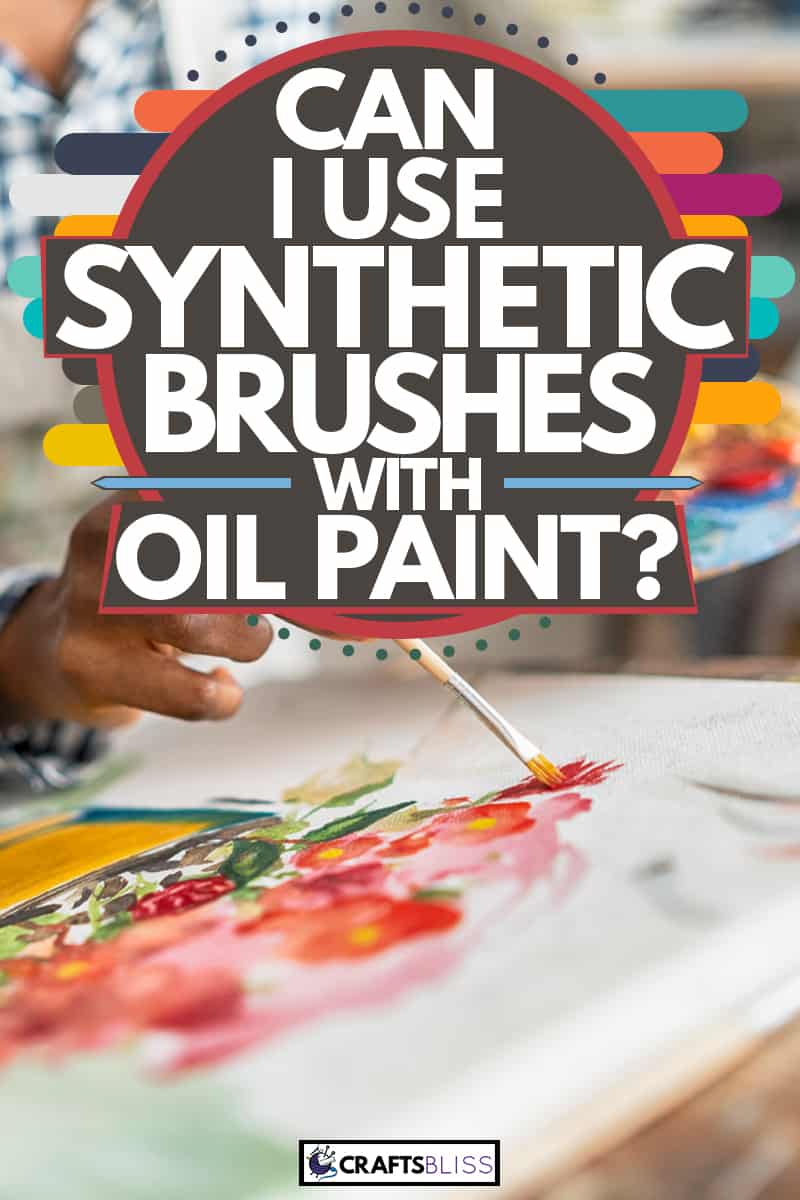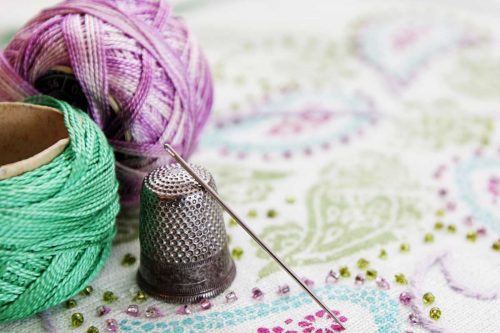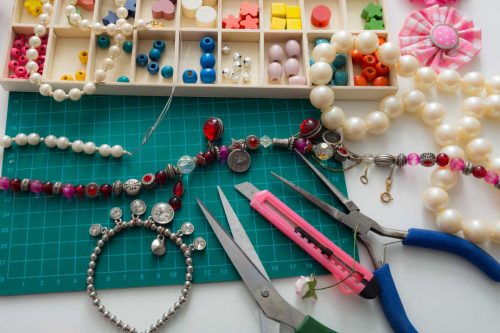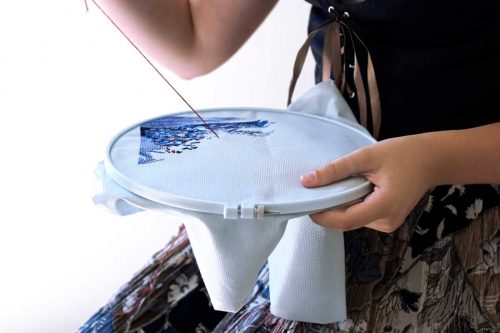The oldest oil paintings in existence date from 650AD on cave walls in Afganistan and the artists of the Renaissance enshrined this medium into the public consciousness through their masterpieces. While these artists were somewhat limited in their brush choice, today we have aisles of brushes to choose from at the craft store, and the additional option between natural and synthetic fibers. If you're overwhelmed by the dizzying number of brushes out there, not to worry; we've done the research to help you decide if synthetic brushes will help you create your next oil masterpiece.
While you can use synthetic brushes for oil painting, make sure that they are made specifically for oil paints. Synthetic brushes made for oil paints will maintain their bristle shape better over time, giving you an affordable option compared to natural bushes and longer-term tools to use to perfect your art.
Why do synthetic brushes need to be made for oil paints? What are the advantages and disadvantages of synthetic brushes? Please keep reading to find out all these answers and more!

Using oil paint with synthetic vs. natural fiber brushes.
Natural fiber brushes used with oil paints are typically made from hog bristle or sable. Hog bristles are for large areas, blocking shapes and washes of color. In comparison, sable bristles are for fine details. These brush fibers are durable and maintain their shape well over time. However, a set can become expensive for a beginner, and they require careful care to maintain fiber shape and integrity. Natural fibers have a "snap" - the ability of the brush to bounce back into shape - making them beloved by many in the art community.
Synthetic brushes are typically cheaper than natural fiber brushes, and they are easier to clean and care for. There are also many shapes, sizes, and textures of synthetic brushes to experiment alongside the more traditional oil painting shapes. Additionally, synthetic brushes are also suitable for use with other paint mediums such as acrylic. However, synthetic sable brushes are not quite as soft and fine as natural ones, meaning that delicate details may be harder to achieve.
Why do synthetic brushes need to be made for oil paints?
In short, un-thinned oil paints are thick and heavy, so brush bristles must be stiff enough to move the paint across a surface and maintain their shape. Natural hog bristle brushes are the fiber of choice to accomplish this over large areas; however, modern synthetic alternatives replicate hog bristle quite well.
Sable brushes, favored for their softness and delicacy, also resist wear and tear. They allow the artist to apply paint precisely for intricate detail and are useful for layering techniques. Synthetic alternatives to sable exist, and care is taken to make sure the synthetic brushes maintain the texture and resilience of the natural fiber counterparts.
While using more standard synthetic brushes is possible, the thickness of the paint may cause them to wear out more quickly, or they might lack the "snap" for crisp and clean details. You can use them for oils, but you should be aware of these potential issues.
What brush is best for oil-based paint?
While many professional painters recommend natural fiber hog bristle and sable brushes, oil paint is a versatile medium that lends itself well to experimentation with paint thickness and brush shape, density, and stiffness. Since oil paints are so versatile, there is no best brush to use with them, and each individual will have their preferences.
For some completely brushless inspiration, check out this video from Kimberly Adams – she created this beautiful painting using nothing but oil paint and her fingers, showing that you don't need a brush to work with oil paint at all! It's a fantastically inspiring watch and showcases the versatility of the medium.
What surfaces can oil paint be used on?
While stretched canvas is the go-to option for oil painting due to its availability, inexpensive nature, variety of size, and relative portability, with proper preparation, many surfaces are used for oil painting. Before the widespread use of canvas, wood panels were the most common, and some artists favor even today for their solid nature.
In addition to the more common wood, use canvas board (canvas adhered to cardboard), metal, watercolor paper, and even plastic sheets with oil paints.
Keep in mind that to use these surfaces with oil paint effectively, they have to be adequately primed. Gesso for wood panels and rabbit skin glue with lead white paint for canvas are the most common primers. However, each surface works best with specific primers. Additionally, you cannot sand modern acrylic Gesso, meaning any imperfections in the primer layer are visible in the finished work. There are many techniques for priming surfaces for oil painting, so don't be afraid to experiment and find what suits you best!
How do you brush oil-based paint?
To brush oil-based paint:
- Start with a primed surface for painting. The surface can be canvas, wood, or any other texture that suits you.
- Mix your chosen paint color and thin with solvent if you so prefer. Thinned paints make for good base washes of color for your painting.
- Dip your brush into the paint and apply it to the surface using hog bristle brushes for wide swaths of color or sable brushes for fine detail.
That's it! There are practically limitless combinations of paint thickness, brush techniques, paint layering, and varnishes to learn about, but fundamentally oil painting is about putting paint onto a surface. Here's a video that shows the steps in more detail and some simple but effective techniques to use with the medium, including distance one single brush will get you. It even starts with some frequently asked questions about oil painting you might be curious about before you get started.
Remember, oil paint has an extremely long drying time (hours to days), which can be extremely useful! Slow drying allows mistakes to be wiped off, colors to be blended on the canvas as you go, and even entire sections of paint removed to create highlights, as shown in the video.
Can you use a foam brush with oil paint?
Yes, you can! Using foam or sponge with oil paint is a fantastic way to experiment with texture thanks to the thickness of oil paint and the porousness of foam. Also, due to oil paint's long drying time, the foam brushes have a longer lifespan than they would with many other paint mediums - the paint can be dabbed or washed out of the sponge after you finish for the day.
Here is a quick video of an artist incorporating sponge painting techniques with oil paint to create a lovely galaxy painting, and exemplifies the usefulness of sponge/foam in creating art. There are countless videos out there showing how easy and beginner-friendly sponge painting is, so don't be afraid to give it a try with oil paint!
Whew! We hope you hung in there for all that! As you can see, you can indeed use synthetic brushes with oil paint - and many other things besides! Oil paints are an extremely flexible medium that lends themselves well to all kinds of brushes and surfaces. We hope that this post has inspired you to experiment with the medium and remember: Art is about expression, so there is no wrong way to do it.

![Read more about the article 8 Best Sewing Machine Oils [Incld. Safe Alternatives To Sewing Machine Oil]](https://craftsbliss.com/wp-content/uploads/2020/11/A-man-pouring-oil-into-the-sewing-machine-to-lubricate-it-1-500x333.jpg)




![Read more about the article Best Glue for Outdoor Mosaics [6 Types]](https://craftsbliss.com/wp-content/uploads/2020/12/CHICAG1-500x333.jpg)